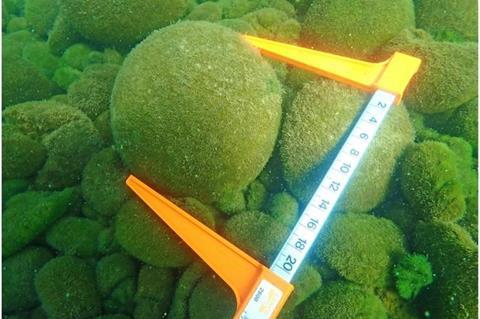Rising lake water temperatures threaten the survival of marimo, unique algal balls found only in cold lakes. Kobe University researchers have clarified that the warmer it gets, the more the inward decomposition outpaces the outward growth of these life forms, making them increasingly fragile.

Moss balls, or “marimo” in Japanese, are popular pet water plants that are not a moss but a special growth form of filamentous algae. They are found naturally in lakes in northern Japan and cold lakes of Europe, including Austria, Iceland, and Sweden.
In recent decades, their global population has been decreasing and now the only place where balls of 20 cm and larger exist is Lake Akan in Hokkaido, the northern island of Japan. However, because of the complex interplay of factors contributing to the growth of marimo, the cause of their decline remains unknown.
Global decline
Kobe University hydroengineer Nakayama Keisuke is an expert on how different layers of water interact and how this affects aquatic life. In the past, this allowed him to elucidate many aspects of what contributes to the growth of marimo, which live at a depth of two to three meters below the surface. He now combined field data from his previous work with accurate measurements of marimo decomposition under lab conditions to clarify the structural and chemical behavior of the life form, shedding light on the cause of its global decline.
The results, now published in the journal Scientific Reports, point at a usual suspect: global warming. Marimo exist because of a delicate balance between external growth and internal decomposition, which is also why the balls are hollow.
However, Nakayama and his team could show that while the growth rate under lab conditions peaks at a water temperature of 22°C, the decomposition rate keeps increasing with the temperature.
“The thickness of the marimo is an important structural characteristic for maintaining its shape, and if the water temperature in Lake Akan rises further in the future due to global warming or other factors, the giant marimo may become even thinner and more fragile,” says Nakayama.
Tracking temperature
To track the influence of the varying temperatures over the year, the researchers use the “cumulative water temperature” measured in °C-days, which is a way of adding up daily temperatures over a chosen time span. To maintain a shell thickness of about 4 cm, marimo require a cumulative water temperature of 1470°C-days or less.
At lake Akan, the cumulative water temperature was 1250°C-days in 1988, but in the past decade it has risen to about 1610°C-days. Correspondingly, the shell thickness was estimated to have decreased from about 4.7 cm to about 3.7 cm. In warmer regions, the cumulative water temperature can exceed 3000°C-days and, therefore, large marimo cannot survive.
Large marimo are now thought to be exclusively found in Lake Akan, and as seen from the data, even there they have become threatened. “Therefore, it is necessary to propose measures to protect marimo from global warming, such as utilizing the cooler river water that flows into the marimo colony,” suggests Nakayama.







No comments yet